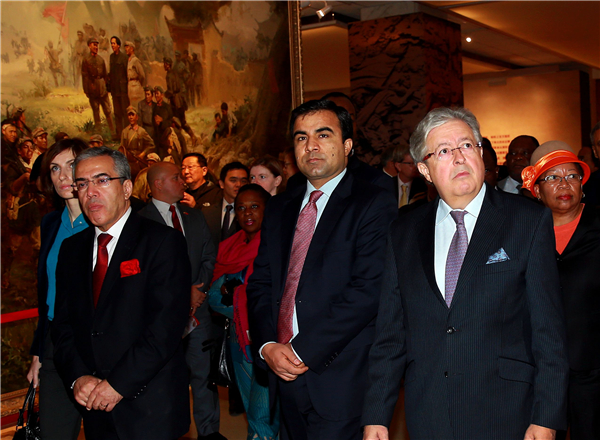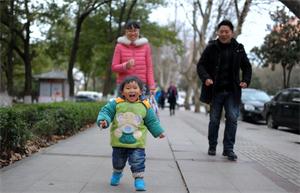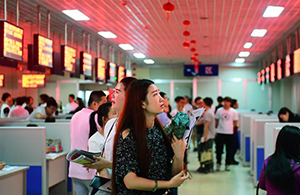The Long March: A Trek of honor and legacy
By Michael Omoruyi (chinadaily.com.cn) Updated: 2016-10-17 15:01
 |
|
Algerian Ambassador to China Ahcene Boukhelfa (from left), Afghan Ambassador Janan Mosazai and Swiss Ambassador Jean-Jacques de Dardel visit the Long March exhibit at the China People's Revolution Military Museum.[Photo by Zhou Hong/China Daily] |
Before I came to China to study, we loved watching Chinese action-packed movies. Since they showed Chinese flying and kicking in the air, we in Nigeria thought all Chinese could kick and fly like that. It was only when I came to China that I realized that the reality was different.
Similarly, my perception of the Long March changed when China Daily gave me an opportunity to witness the 80th anniversary of the epic expedition.
To be honest, I did not know much about the Long March, but became fascinated with it after I read about it.
While the Chinese refer to it as “the Long March of the Red Army”, I refer to it as the march of unifying the people, a march that stands as the turning point to save the most vigorous forces to lead China from darkness to light, without which China may have turned out to be totally different.
Rarely does one historical incident have such a huge influence on people. The after-effects were felt for over seven decades and shaped China’s position in the world. Also, the long March carries a lofty meaning and a spiritual space for the Chinese people. It taught them how to be each other’s keeper and receptive to the outside world; it also gave them the much needed stability and a springboard for speedy economic development.
The symbolic power of the expedition is just as important as the military victories. So when the Chinese are discussing the Long March, they should remember that the spirit of the Long March was used for many years for two things: Honor and Legacy. They should use the Long March to urge people to honor the sacrifice of those who fought hard to make sure there was peace in China today and leave a legacy of heroism and dedication for the younger generation to belief that impossible project can be achieved.
The Long March, after eight decades, retains a powerful legacy in China. Ceremonies are important. But our gratitude has to be more than visits to the cities affected. We honor the dead best by treating the living well. So, on this 80th anniversary, perhaps the highest tribute that can be paid to the veterans of the Long March is to do what should have been done the day they came home. In our hurried life, let’s pause, listen and allow these veterans carried us back to the days of their youth, and let us be impressed by their exceptionalsacrifices.
From the Long March, I observed that group effort is essential, and when personal ambitions and differences are put aside when greater good demands it, it can build a nation, build an element that tie the people together and make them better, stronger and greater. That is what most nations struggling with conflict can learn from China – the spirit of rebuilding people together during conflict. I always say this to people,“It is time we need to see people as human being and not as object or tools. If we see them as human being, we will be move to serve them rather than to exploit them.” That is the spirit of the Long March; the spirit of working hard, not exploiting your neighbors, not seeing your fellow citizen as a tool to be used and thrown away, strong belief in communism and the ultimate rebuilding of a new China, fearing no sacrifice, because sacrifice is like the “brick stones” we need to build a nation.
Recently in a speech given by President Xi Jinping at an event marking the 80th anniversary of the spirit of the Long March, he said “time may have changed, the situation may have changed, but the ideals and causes that the communists have been fighting for have not changed.” China needs to march ahead with confidence and courage in “a new long march” that will bring prosperity and national greatness to the country. In terms of prosperity, the epic march has helped China lifted more people out of poverty than anywhere else in the world. Also, China has helped developing countries reshaped their economies. Champions are not defined by the titles they win or by the wealth they have, champions are defined by the number of people they put smiles on their faces.
Today, China is seen as the leading champion in development among developing countries, supporting peace in nations facing conflicts and providing aid to other developing nations without any conditions attached. The epic narrative contained the beauty of human nature that can exceed social systematic and ideological barriers, which have contributed very much to its universal impact. The Long March is a significant symbol of China, and a window for foreigners to know about the nation, which makes it an inevitable part of the Chinese narrative, engraved on a memorial pillar that will not be forgotten by generations of people globally.
Michael Omoruyi is a researcher from Institute of African Stuties Zhejiang Normal University












